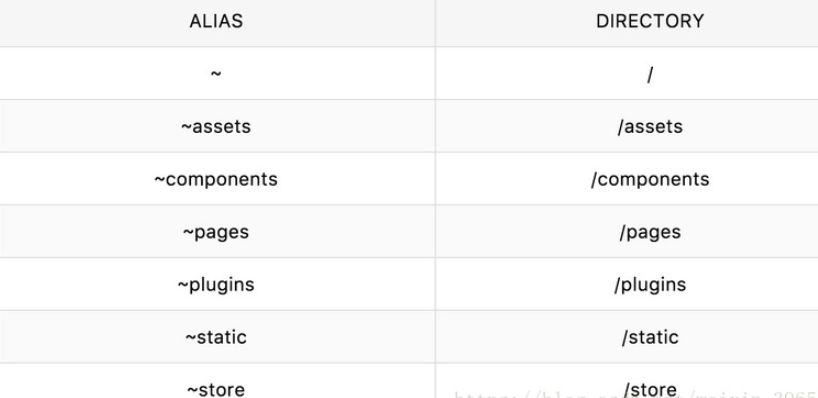1.NUXT是什么?
Nuxt.js简单的说是Vue.js的通用框架,最常用的就是用来作SSR(服务器端渲染)。
首先说下 SSR,最近很热的词,意为 Server Side Rendering(服务端渲染),目的是为了解决单页面应用的 SEO 的问题,对于一般网站影响不大,但是对于论坛类,内容类网站来说是致命的,搜索引擎无法抓取页面相关内容,也就是用户搜不到此网站的相关信息。
SSR 还适用以下场景
1、客户端的网络比较慢
2、客户端运行在老的或者直接没有 JavaScript 引擎上
2.NUXT为什么?
vue开发的SPA(单页应用)不利于搜索引擎的SEO优化。
3.NUXT适用于:
Nuxt.js适合作新闻、博客、电影、咨询等需要搜索引擎提供流量的项目。
4.NUXT优点:
基于 Vue.js
自动代码分层
服务端渲染
强大的路由功能,支持异步数据
静态文件服务
ES6/ES7 语法支持
打包和压缩 JS 和 CSS
HTML头部标签管理
本地开发支持热加载
集成ESLint
支持各种样式预处理器: SASS、LESS、 Stylus等
安装流程
Nuxt.js 团队提供了 vue-cli 的初始化模板。前提安装 vue-cli,安装过的忽略此步
npm install -g vue-cli
完成后在需要创建的目录下执行以下
vue init nuxt/starter <project-name>
cd <project-name>
npm install
依赖安装完成后
npm run dev
打开浏览器 http://localhost:3000
目录结构
完成上面命令后你的目录结构会如下

文件的路径建议都采用绝对路径,表格如下

例:怎么在 /pages/user/me.vue 引入一个 static 文件夹里的图片
<img src="~static/img/logo.png" alt="Logo"/>
路由
Nuxt.js 根据 pages 目录结构去生成 vue-router 配置,也就是说 pages 目录的结构直接影响路由结构
例1:
|-- pages
|-- posts
|-- index.vue
|-- welcome.vue
|-- about.vue
|-- index.vue
会生成
routes: [
{
path: '/posts',
component: '~pages/posts/index.vue'
}, {
path: '/posts/welcome',
component: '~pages/posts/welcome.vue'
}, {
path: '/about',
component: '~pages/about.vue'
}, {
path: '/',
component: '~pages/index.vue'
}
]
例2:隐藏路由
在文件名前加 _
|-- pages
|-- _about.vue
|-- index.vue
会生成:
routes: [
{
path: '/',
component: '~pages/index.vue'
}
]
配置文件
目录下的 nuxt.config.js 是我们唯一的配置入口,这里不建议修改 .nuxt 目录,除非特殊需求
默认的给力我们三个配置 ·head·css·loading· 分别是头部设置,全局css,loading进度条
nuxt.config.js 的全部的配置如下,点击查看具体例子
1、cache
2、loading
3、router
4、css
5、plugins
6、head
另外还提供了 vuex 等配置,感兴趣可以去 github 和官网。
其他一些配置的引用
安装需要的loader后指定lang就可以直接使用。
npm i less less-loader --save--dev
//全局css
css: [
{
src: 'static/less/base.sass',
lang: 'less'
}
],
//页面中使用
<style lang="less" scoped></style>
loading
//禁用
module.exports = {
loading: false
}
//颜色条
module.exports = {
loading: { color: '#3B8070' }
}
//使用组件
添加一个loading组件 (官方示例如下,详情可看官方文档)
引用该组件
module.exports = {
loading: '~components/loading.vue'
}
/// components/loading.vue
<template lang="html">
<div class="loading-page" v-if="loading">
<p>Loading...</p>
</div>
</template>
<script>
export default {
data: () => ({
loading: false
}),
methods: {
start () {
this.loading = true
},
finish () {
this.loading = false
}
}
}
</script>
<style scoped>
.loading-page {
position: fixed;
top: 0;
left: 0;
width: 100%;
height: 100%;
background: rgba(255, 255, 255, 0.8);
text-align: center;
padding-top: 200px;
font-size: 30px;
font-family: sans-serif;
}
</style>
使用插件、第三方模块
//通过script标签
head: {
script: [
{ src: 'https://res.wx.qq.com/open/js/jweixin-1.2.0.js' }
]
},
//plugins配置 , ssr:false 设置只在客户端使用
plugins: [
{ src: '~plugins/flexible.js', ssr: false }
],
//在页面中使用axios,配置vendor使其只打包一次
//页面
<template>
<h1>{{ title }}</h1>
</template>
<script>
import axios from 'axios'
export default {
async asyncData ({ params }) {
let { data } = await axios.get(`https://my-api/posts/${params.id}`)
return { title: data.title }
}
}
</script>
//配置文件
module.exports = {
build: {
vendor: ['axios']
}
}
使用第三方组件库
在nuxt里使用第三方UI组件库也非常简单。以iview为例
///在plugins下新建 iview.js
import Vue from 'vue'
import iView from 'iview';
Vue.use(iView);
////配置文件引入css和plugin
module.exports = {
css: [
{ src: 'iview/dist/styles/iview.css'}
],
plugins: [
{ src: '~plugins/iview.js', ssr: false }
],
}
asyncData
nuxt扩展的异步数据方法,对于页面数据,我们一般有页面data定义的形式和vuex统一管理的形式,可以根据自己的需求选择。
data定义这里就不赘述了,这里说一下vuex统一管理数据的做法。
///page页面
<template>
<div class="container">
<p class="title">数据展示!</p>
<Table :columns="columns1" :data="data1"></Table>
</div>
</template>
<script>
import { mapState } from 'vuex'
import axios from 'axios'
export default {
middleware: 'auth', //定义页面中间件
head () {
return {
title: '其他页面'
}
},
data () {
return {}
},
async fetch ({ store, params }) {
let { data } = await axios.get('http://106.14.205.222/article/list?page=1&limit=10&isActive=1')
console.log( data )
store.commit('SET_LIST', data.list)
},
computed: {
...mapState([
// 映射 this.xxx 为 store.state.xxx
'columns1',
'data1'
])
},
}
</script>
//store index.js
import Vue from 'vue'
import Vuex from 'vuex'
Vue.use(Vuex)
const store = () => new Vuex.Store({
state: {
columns1: [
{
title: '标题',
key: 'title'
},
{
title: '介绍',
key: 'intro'
},
{
title: '日期',
key: 'time'
}
],
data1: [],
user: 'xu' //如果为空,则会中间件控制跳转404
},
mutations: {
SET_LIST: (state, data) => {
state.data1 = data
},
}
})
export default store


